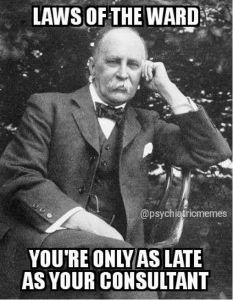Read time: 5 minutes
In this blog post, Jessica Xie (final year UCL medical student) explains what a ward round is and how to get the most out of this clinical experience.
Hey fourth years! Congratulations on passing your exams and welcome to clinical years (the more exciting part of medical school). I’m going to take you through the ins and outs of ward rounds by answering some commonly-asked questions.
The Basics
Q: What is a ward round?
A: A ward round is when the doctors ± other members of the multidisciplinary healthcare team (MDT) (e.g. doctors, nurses, ward coordinator) visit all the in-patients.
Ward rounds take place first-thing in the morning (between 7 – 10am).
Typically 3 – 4 healthcare professionals (HCPs) will attend the WR, but I’ve been on WRs when it has been just myself and 1 doctor, and other times there have been over 7 people!
There are several important roles on the ward round:
-
-
- The most senior member (most likely a consultant) leads the ward round. They will greet the patient and ask how they are feeling that morning, perform an examination and decide the management plan
- Scribe – to write down team decisions and document the ward round
- Someone to check any relevant charts (e.g. observations, fluid balance)
-
Q: What should I expect?
A:
-
- To be treated as a member of the MDT
- To learn medicine! Most doctors are happy to teach students at a patient’s bedside or between seeing patients
- You may be asked to help out (see ‘During the Ward Round’ below)
Preparation
Q: Where does the ward round start?
A: You will be expected to attend handover if you are scheduled ward round. A handover is a meeting during which the night team (staff who did the night shift) ‘handover’ the patients to the day team to look after. The night team will report if anything significant occurred during their shift. Handover is really important to make sure that the whole team (including yourself) is on the same page and that any incomplete ‘jobs’ (tasks related to patient care that need to be done (e.g. venepuncture)) are passed on to the day team taking over to ensure that the tasks get done!
Q: What do I need to bring with me?
A: These items are essential to ensure that you are ready to learn and contribute to the ward round.
-
-
- Stethoscope
- Black pen
- Notebook or tablet/ iPad
- Handover sheet from handover meeting
- Mobile phone
- Put on silent
- I recommend that you download a few of these apps:
- BNF
- Microguide
- UpToDate
- MDCalc
-
Q: How can I maximise my learning outputs?
A: I recommend that you set yourself at least one goal to achieve by the end of the ward round. This will keep you focused and ensure that you walk away having gained at least one thing. Examples of goals:
-
-
- To ask questions
- To ask a doctor about the aetiology, management or progression of a specific condition
- To WITN (see ‘During the Ward Round’ below)
- To get a mini-CEX or CbD signed off
- Clerk and SBAR (see ‘During the Ward Round’ below)
- To examine a patient (see ‘During the Ward Round’ below)
- To write a prescription
-
During the Ward Round
Q: What can I do to contribute to the ward round?
A: There are many things that you can do!
-
- Write in the notes (WITN)
Here’s a useful guide. I highly recommend that you observe doctors WITN before you attempt to. Offer to ‘prepare the notes’, which means writing the subheadings, observations and test results before the patient is reviewed by the WR team in preparation for you or someone else to WITN.
2. Take a brief history/ clerk a patient and present to the ward round team in SBAR format
3. Examine patients
Refresh your memory of examinations. It can be nerve-racking examining patients in front of senior colleagues, but remember that they were once in your shoes too. Do not miss the excellent learning opportunities offered on ward rounds: you will receive immediate, valuable face-to-face feedback.
4. Practice prescribing
Here’s a useful guide. Use the apps (see ‘Preparation’ above) on your phone to look up drug doses.
5. Ask questions
Depending on how busy the doctors are and their teaching style, you may be able to ask questions between seeing patients or at the end of the ward round. Jot down any questions in your notebook, on your tablet/ iPad or next to the patient’s name on your handover sheet.
After the Ward Round
Thank the staff for taking you on the ward round. Now might be an appropriate to time to ask doctors any questions.
Review any notes that you made during the ward round – repetition is key to understanding concepts and committing facts to memory!
By the end of a ward round, a list of ‘jobs’ will have been created (e.g. cannulation), which the doctors divided amongst themselves. You can offer to do some of these jobs.
Remember to DISPOSE OF YOUR HANDOVER SHEET in the confidential waste bin.
That’s all for this first post. I hope I’ve made the idea of attending a ward round less daunting. Ward rounds are excellent learning opportunities if you come prepared and know what you want to achieve. If you have any questions or comments, feel free to reach out to any of us.
Good luck,
Jess

Amazing. Thanks for sharing with us.Science mnemonic